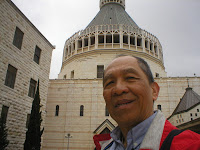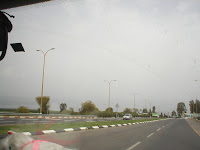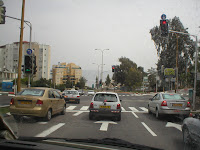PILGRIMAGE through Israel - Part 4
APRIL 7 - HOLY SATURDAY
With 4 other Pinoy, I took a tour under the Alternative Tours & Transportation which was "a day trip to the north: includes a drive through the Jordan Valley, a stop at the site of John the Baptist (Jordan River), visits to the city and holy places of Nazareth, the Church of Multiplication in Taghba and Tiberias."

On the highway from Jerusalem to the north.

The Basilica of the Annunciation as can be seen from the road approaching Nazareth.

as the place of the Annunciation also in Nazareth. There is a gate in front of the shrine as well as the Well of Mary.

Inside the shrine; pilgrims kneel on the spot where the angel Gabriel appeared to Mary.


site believed to be where Gabriel appeared to Mary. It is under the Franciscans.


Around
the basilica are various artworks from other countries interpreting the Annunciation scene. This one is from
the Philippines.

This spot inside the Basilica is zhere Gabriel appeared to Mary.



A Franciscan monk prepares the statue of the Dead Jesus for the vigil rites.


Beside the Basilica of the Annunciation is the Church of St. Joseph. Here is where Jesus grew up while learning the carpentry skills under Joseph.

 On the road to Cana.
On the road to Cana. Like the site of the Annunciation, there are also two sites where the miracle of Cana took place: The Catholic one was closed when we passed by so we were not able to see the inside of the shrine.
Like the site of the Annunciation, there are also two sites where the miracle of Cana took place: The Catholic one was closed when we passed by so we were not able to see the inside of the shrine.


 This is the one of the Greek Orthodox Church which was open; we saw the inside of the Church which has a big painting of the miracle when Jesus changed water into wine.
This is the one of the Greek Orthodox Church which was open; we saw the inside of the Church which has a big painting of the miracle when Jesus changed water into wine.



On the highway leading towards Galilee.




 Our visit to Capernaum where Jesus spent his years of ministry by the side of the lake of Tiberias (Sea of Galilee).
Our visit to Capernaum where Jesus spent his years of ministry by the side of the lake of Tiberias (Sea of Galilee).
This is the inside view of the
shrine which
is built on top of the stone remains of the house of Peter.

These are the stones believed to be the remnants of the house of Peter in Capernaum.

The synagogue near the house of Peter.


The stones used as equipment to press olives into oil.


One has a view of the Sea of Galilee from
from this hill.



A visit to the Jordan River where pilgrims/tourists were reminded of Jesus' baptism by John the Baptist. This, however, is not the exact site. Pilgrims put water in plastic bottles as souvenirs to take home. During our visit, there were a number of Pinay OFWs who were on a pilgrimage.


 After attending the rites at the Holy Sepulchre, we also attended the early morning service at the Garden Tomb. This is the garden preserved by Protestants since 1893 as the alternate Sepulchre and Garden of Joseph of Arimathea.
After attending the rites at the Holy Sepulchre, we also attended the early morning service at the Garden Tomb. This is the garden preserved by Protestants since 1893 as the alternate Sepulchre and Garden of Joseph of Arimathea.



Greek Orthodox rites at the Holy
Sepulchre Basilica. The rites took place
right in front of the center of the
basilica believed to be where the tomb
of Jesus was and where the
Resurrection took place. There was
a huge crowd of people at the

Mt. Olives at dawn on Easter Sunday.
 After attending the rites at the Holy Sepulchre, we also attended the early morning service at the Garden Tomb. This is the garden preserved by Protestants since 1893 as the alternate Sepulchre and Garden of Joseph of Arimathea.
After attending the rites at the Holy Sepulchre, we also attended the early morning service at the Garden Tomb. This is the garden preserved by Protestants since 1893 as the alternate Sepulchre and Garden of Joseph of Arimathea.
The Damascus Gate (Bab Al-'Amoud)

These photos were taken from the top veranda of Ecce Homo. This spot provides the pilgrim with an awesome view of the Old City. Parts of the Muslim, Christian, Jewish and Armenian quarters can be seen from this vantage point. One sees the Dome of the Rock, the five minarets of the mosques, the towers and belfries of the churches, cathedrals and basilicas (especially the Church of the Holy Sepulchere) and roofs of synagogues. It is a commanding view that sticks to one's memory, especially as seen on Easter Sunday morning!
















After attending the early Easter Sunday liturgical celebrations, I took a walk from Ecce Homo down part of Via Dolorosa, then Al Wad St. towards the Jews Quarter of the Old City where the Western (referred to also as wailing) Wall. There were already quite a number of Jews there roaming around the square or reading the Scriptures before the wall or praying intensely. The wooden bridge that one can see at the center of the square is the bridge that pilgrims could use if they want to enter into the Dome of the Rock. This is the only entrance for non-Muslims who want to see the Dome. Very ironic, indeed!











On my last day in Jerusalem, Easter Sunday, I went around the Old City and took photos of the stores lining the streets. Indeed, the streets of Old Jerusalem double as sites of the market stalls meant mainly for the tourists and pilgrims with cash to spend. This is why prices tend to be more expensive than outside the Old City. One has to really take advantage of bargaining skills. All sort of products are sold: clothing materials, jewelry, bread, sweets, fruits, herbs, spices, souvernir items, religious articles, ceramics, wood carvings and thousands of other stuff. What is interesting is that you have Palestinian Arab Muslims selling Christian religious symbols. Reminds me of Maranaws selling Last Supper wall decors ("si Jesus uban sa iyang barkada").















0 Comments:
Post a Comment
<< Home